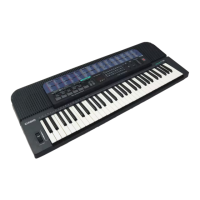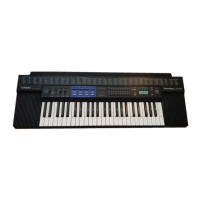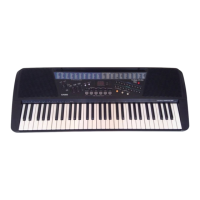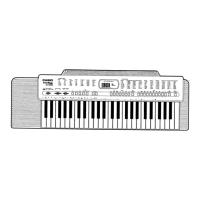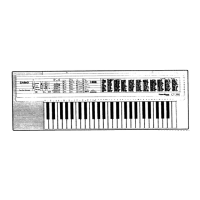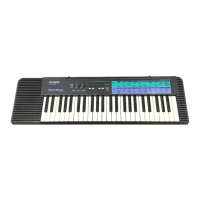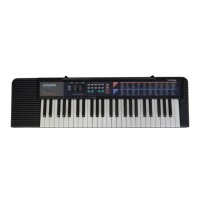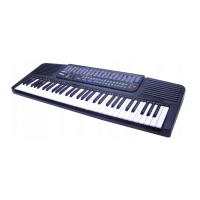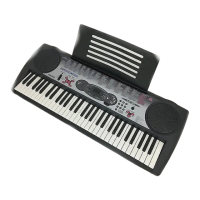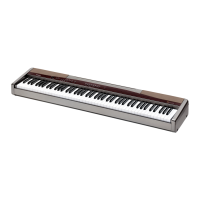Do you have a question about the Casio ToneBank CT-670 and is the answer not in the manual?
Explains the unit's preset demonstration tune and how to play it.
Details powering the unit using dry batteries, including precautions.
Explains using an optional AC adaptor for household power.
Basic steps to turn on the unit and begin playing.
Describes the MAIN, ACCOMP, and RHYTHM volume sliders.
Explains pitch bending and fine-tuning adjustments.
Guide to selecting basic tones using tone selectors.
Instructions for selecting bank sounds after activating the TONE BANK button.
How some tones split the keyboard into different sound zones.
Instructions for selecting basic auto-rhythm patterns using beat selectors.
Instructions for selecting bank rhythms after activating the BEAT BANK button.
How to start, stop, and control tempo for auto-rhythms.
Explains the lower keys used for playing accompaniments.
How to play accompaniments using the Casio Chord system.
Explains the logic of forming major, minor, and seventh chords.
How to play accompaniments using the fingered chord method.
Details how to use buttons like INTRO, BREAK, FILL-IN for accompaniment control.
Controls for inserting fill-ins, endings, and coda patterns into accompaniments.
How to use the Synchro button for rhythm start.
Controls for switching accompaniment sound elements ON and OFF.
Controls for Auto Harmonize and Echo Line effects.
Adjusts tuning for chorus effect in the right channel output.
Creates echo effects by delaying the right channel output.
Controls the attack and decay points of the sound.
Controls the attenuation of the note's sound.
Guide to recording played notes and operations into memory.
Instructions on how to play back recorded performances.
Important points and limitations regarding recording.
Important points and limitations regarding playback.
Introduction to MIDI and its purpose for musical instruments.
Explains the MIDI IN, OUT, and THRU ports.
Details on setting MIDI modes (A and B).
How to set transmit channels in MODE B.
Assigning preset tones to MIDI channels in MODE B.
How to set the MIDI clock to internal or external.
Adjusting volume for tones assigned to each MIDI channel.
Examples of using the CT-670 with MIDI devices.
How to connect the CT-670 to another MIDI keyboard.
Using the CT-670 with a multi-track sequencer in MODE B.
Chart showing tone numbers and their corresponding MIDI program change numbers.
Chart showing beat numbers and their corresponding MIDI program change numbers.
Details the polyphony limits for each MIDI channel.
Explains the unit's preset demonstration tune and how to play it.
Details powering the unit using dry batteries, including precautions.
Explains using an optional AC adaptor for household power.
Basic steps to turn on the unit and begin playing.
Describes the MAIN, ACCOMP, and RHYTHM volume sliders.
Explains pitch bending and fine-tuning adjustments.
Guide to selecting basic tones using tone selectors.
Instructions for selecting bank sounds after activating the TONE BANK button.
How some tones split the keyboard into different sound zones.
Instructions for selecting basic auto-rhythm patterns using beat selectors.
Instructions for selecting bank rhythms after activating the BEAT BANK button.
How to start, stop, and control tempo for auto-rhythms.
Explains the lower keys used for playing accompaniments.
How to play accompaniments using the Casio Chord system.
Explains the logic of forming major, minor, and seventh chords.
How to play accompaniments using the fingered chord method.
Details how to use buttons like INTRO, BREAK, FILL-IN for accompaniment control.
Controls for inserting fill-ins, endings, and coda patterns into accompaniments.
How to use the Synchro button for rhythm start.
Controls for switching accompaniment sound elements ON and OFF.
Controls for Auto Harmonize and Echo Line effects.
Adjusts tuning for chorus effect in the right channel output.
Creates echo effects by delaying the right channel output.
Controls the attack and decay points of the sound.
Controls the attenuation of the note's sound.
Guide to recording played notes and operations into memory.
Instructions on how to play back recorded performances.
Important points and limitations regarding recording.
Important points and limitations regarding playback.
Introduction to MIDI and its purpose for musical instruments.
Explains the MIDI IN, OUT, and THRU ports.
Details on setting MIDI modes (A and B).
How to set transmit channels in MODE B.
Assigning preset tones to MIDI channels in MODE B.
How to set the MIDI clock to internal or external.
Adjusting volume for tones assigned to each MIDI channel.
Examples of using the CT-670 with MIDI devices.
How to connect the CT-670 to another MIDI keyboard.
Using the CT-670 with a multi-track sequencer in MODE B.
Chart showing tone numbers and their corresponding MIDI program change numbers.
Chart showing beat numbers and their corresponding MIDI program change numbers.
Details the polyphony limits for each MIDI channel.
| Preset Tones | 210 |
|---|---|
| Rhythms | 110 |
| Keys | 61 |
| MIDI | Yes |
| Brand | Casio |
| Model | CT-670 |
| Accompaniment | Yes |
| Display | LCD |
| Power | AC Adapter or 6 x D batteries |
| Effects | Reverb |
| Polyphony | 12 notes |
| Type | Keyboard |
